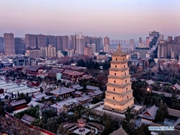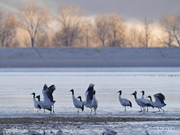

Editor's note: As the Hong Kong-Zhuhai-Macao Bridge opens to traffic today, here is what you need to know about the world's longest sea-crossing bridge.
An aerial view of the Hong Kong-Zhuhai-Macao Bridge. At 55 kilometers, the bridge is the world's longest sea-spanning structure. [Photo/HZMB AUTHORITY]
1. Vehicles that could use the bridge
Among the vehicle types authorized to use the Hong Kong-Zhuhai-Macao Bridge, shuttle buses will run only between the ports of Hong Kong and Zhuhai/Macao, not crossing any boundaries.
Cross-boundary coaches via HZMB will operate similarly to current coaches that run between the Chinese mainland and the two special administrative regions through existing ports, such as the Shenzhen Bay Port.
Cross-boundary private cars under quotas for existing boundary crossings (i.e. Shenzhen Bay and Lok Ma Chau) will be allowed to use the Hong Kong-Zhuhai-Macao Bridge without additional procedures on a trial basis.
According to figures from the Transport Department in Hong Kong, the number of Hong Kong cross-boundary private cars issued with valid Closed Road Permits (CRP) was 30,400 as of 2017.
The number of mainland cross-border boundary cars with such permits is more than 20,000, according to the bridge operator, HZMB Authority.
Governments in Hong Kong and the mainland have both promised flexible adjustment of quotas for cross- boundary private cars in accordance with the traffic volume after the bridge opens.
 |

 Award-winning photos show poverty reduction achievements in NE China's Jilin province
Award-winning photos show poverty reduction achievements in NE China's Jilin province People dance to greet advent of New Year in Ameiqituo Town, Guizhou
People dance to greet advent of New Year in Ameiqituo Town, Guizhou Fire brigade in Shanghai holds group wedding
Fire brigade in Shanghai holds group wedding Tourists enjoy ice sculptures in Datan Town, north China
Tourists enjoy ice sculptures in Datan Town, north China Sunset scenery of Dayan Pagoda in Xi'an
Sunset scenery of Dayan Pagoda in Xi'an Tourists have fun at scenic spot in Nanlong Town, NW China
Tourists have fun at scenic spot in Nanlong Town, NW China Harbin attracts tourists by making best use of ice in winter
Harbin attracts tourists by making best use of ice in winter In pics: FIS Alpine Ski Women's World Cup Slalom
In pics: FIS Alpine Ski Women's World Cup Slalom Black-necked cranes rest at reservoir in Lhunzhub County, Lhasa
Black-necked cranes rest at reservoir in Lhunzhub County, Lhasa China's FAST telescope will be available to foreign scientists in April
China's FAST telescope will be available to foreign scientists in April